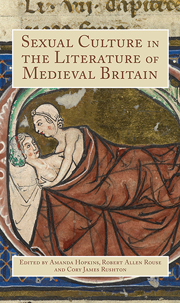Book contents
- Frontmatter
- Contents
- Introduction A Light Thrown upon Darkness: Writing about Medieval British Sexuality
- 1 ‘Open manslaughter and bold bawdry’: Male Sexuality as a Cause of Disruption in Malory's Morte Darthur
- 2 Erotic (Subject) Positions in Chaucer's Merchant's Tale
- 3 Enter the Bedroom: Managing Space for the Erotic in Middle English Romance
- 4 ‘Naked as a nedyll’: The Eroticism of Malory's Elaine
- 5 ‘How love and I togedre met’: Gower, Amans and the Lessons of Venus in the Confessio Amantis
- 6 ‘Bogeysliche as a boye’: Performing Sexuality in William of Palerne
- 7 Fairy Lovers: Sexuality, Order and Narrative in Medieval Romance
- 8 Text as Stone: Desire, Sex, and the Figurative Hermaphrodite in the Ordinal and Compound of Alchemy
- 9 Animality, Sexuality and the Abject in Three of Dunbar's Satirical Poems
- 10 The Awful Passion of Pandarus
- 11 Invisible Woman: Rape as a Chivalric Necessity in Medieval Romance
- Notes on Contributors
- Index
8 - Text as Stone: Desire, Sex, and the Figurative Hermaphrodite in the Ordinal and Compound of Alchemy
Published online by Cambridge University Press: 05 August 2014
- Frontmatter
- Contents
- Introduction A Light Thrown upon Darkness: Writing about Medieval British Sexuality
- 1 ‘Open manslaughter and bold bawdry’: Male Sexuality as a Cause of Disruption in Malory's Morte Darthur
- 2 Erotic (Subject) Positions in Chaucer's Merchant's Tale
- 3 Enter the Bedroom: Managing Space for the Erotic in Middle English Romance
- 4 ‘Naked as a nedyll’: The Eroticism of Malory's Elaine
- 5 ‘How love and I togedre met’: Gower, Amans and the Lessons of Venus in the Confessio Amantis
- 6 ‘Bogeysliche as a boye’: Performing Sexuality in William of Palerne
- 7 Fairy Lovers: Sexuality, Order and Narrative in Medieval Romance
- 8 Text as Stone: Desire, Sex, and the Figurative Hermaphrodite in the Ordinal and Compound of Alchemy
- 9 Animality, Sexuality and the Abject in Three of Dunbar's Satirical Poems
- 10 The Awful Passion of Pandarus
- 11 Invisible Woman: Rape as a Chivalric Necessity in Medieval Romance
- Notes on Contributors
- Index
Summary
George Ripley, in his apostrophic preface to God in the Compound of Alchemy, claims to have ‘renounced … fleshly lust’ and asks God to provide him (and, presumably, other worthy alchemists) with His ‘secret treasure’: ‘Shew us thy secrets and to us be bounteous’ (21.4). Throughout the Compound, Ripley guides readers away from worldly pleasures, urging them instead to focus their desires on God-granted alchemical secrets and ‘our stone of great delight’ (37.2). Likewise, Thomas Norton, in his prologue to the Ordinal of Alchemy, warns of avaricious would-be alchemists who ‘in fyre / Of brennyng couetise haue therto desire’ (27–8). Norton emphatically shuns ‘wordly werkis’ in favour of alchemical ‘connyng’, advising his reader to ‘sett fully his trust’ in God and ‘in connyng be fixid al his lust’ (509, 517, 535–6): ‘For above all erthlye thynge / I mooste desire & love connynge’ (2595–6). Desire or lust, in both the Compound and the Ordinal, is thus redirected from the physical body and material world toward the divinely inspired knowledge of the alchemical corpus. Moreover, as I will illustrate, Norton and Ripley both direct their reader to focus on the text's rhetorical structures in order to achieve desired alchemical objectives.
- Type
- Chapter
- Information
- Sexual Culture in the Literature of Medieval Britain , pp. 111 - 126Publisher: Boydell & BrewerPrint publication year: 2014



